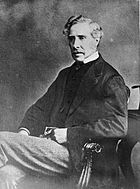New Zealand general election, 1879
|
|
|||||||||||||||||||||||||||||||
|---|---|---|---|---|---|---|---|---|---|---|---|---|---|---|---|---|---|---|---|---|---|---|---|---|---|---|---|---|---|---|---|
|
|||||||||||||||||||||||||||||||
|
|
|||||||||||||||||||||||||||||||
|
All 88 seats in the New Zealand House of Representatives |
|||||||||||||||||||||||||||||||
| Turnout | 66.5% | ||||||||||||||||||||||||||||||
|
|||||||||||||||||||||||||||||||
|
|||||||||||||||||||||||||||||||
The New Zealand general election of 1879 was held between 28 August and 15 September 1879 to elect a total of 88 MPs to the 7th session of the New Zealand Parliament. The Māori vote was held on 8 September. A total of 82,271 (66.5%) European voters turned out to vote, plus 14,553 Māori voters. Following the election, John Hall formed a new government.
Formal political parties had not been established yet; this only happened after the 1890 election. The same 73 electorates were used as for the last election, which was held in 1875–76. In October 1875, Parliament passed the Representation Act 1875, which resolved to increase the size of Parliament to 88 representatives across the 73 electorates.
Two of the electorates were represented by three members each (Christchurch and Dunedin). A further eleven electorates were represented by two members each (Auckland West, Franklin, Grey Valley, Hokitika, Napier, City of Nelson, Thames, Wairarapa, Waitaki, Wanganui and City of Wellington). The remaining 60 electorates were represented by a single member each.
...
Wikipedia


